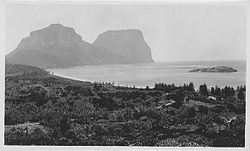- Mount Gower
-
 Mount Gower (centre) and Mount Lidgbird (left) from the north.
Mount Gower (centre) and Mount Lidgbird (left) from the north.
Mount Gower dominates the southern tip of Lord Howe Island and has its peak at 875 metres (2,870 ft).
Average climbing time to Mount Gower's summit is 8 – 10 hours. The path is rope-assisted and rated as one of the world's best one-day hikes. The trail begins at a beach of ankle-turning rocks, from where hikers must scramble up a trail that disappears vertically into the forest on the lower slopes of Mount Lidgbird. The ascent of Mt Gower stands head and shoulders above the rest. The views are unparalleled, the climb takes you through habitats that are found nowhere else on the island and the sense of accomplishment at the end of the day makes it worth every step. Since there are hazards along the way, this can only be done as a guided walk.[1]
Mount Gower has domestic animal and plant species:
- Lord Howe Woodhen - a flightless bird species rescued from the brink of extinction by the world’s first successful captive breeding program.
- Kentia palm forests - unique to Lord Howe island.
At the top of Mount Gower you can :
- Admire the rainforest, with some species that originated in New Zealand.
- View of Ball's Pyramid, a 600m rock spire erupting from the sea.
- See the panoramic sunset views across the lagoon from Signal Point.
The sea-cliffs on three sides of Mount Gower are the highest in Australia. Mount Gower is an ancient volcanic plug, therefore the mountain is flat-topped. The cliffs drop straight into deep water at their base. The great swells of the Pacific crash spectacularly into the base of the cliffs.
References
Coordinates: 31°35′S 159°05′E / 31.583°S 159.083°E
Categories:- Ecoregions of Australia
- Tropical and subtropical moist broadleaf forests
- World Heritage Sites in Australia
- Lord Howe Island
- Shield volcanoes
- Hotspot volcanoes
- Volcanoes of New South Wales
- Mountains of New South Wales
- Volcanoes of the Pacific Ocean
- Volcanoes of Zealandia
- Extinct volcanoes
- Miocene volcanism
- Polygenetic volcanoes
- New South Wales geography stubs
Wikimedia Foundation. 2010.
